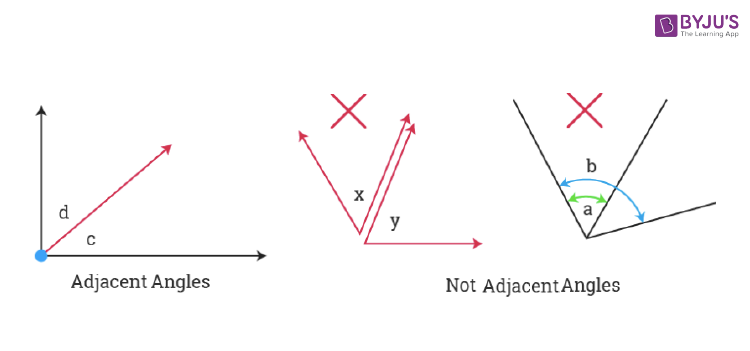Explain What Is Difference Between Adjacent Angles and Vertical Angles
The angles are next to each other have common vertex and share the common side. Explore the definition and characteristics of complementary supplementary vertical and adjacent.
And you might say wait they look like theyre horizontal theyre next to each other.

. Those two adjacent angles will always add to 180. Opposite angles are formed when two lines intersect each other and they are always located opposite to each other. Adjacent angles share a common arm between them and they are always located next to each other.
Angle CEB and angle AED are also vertical. Let First angle m degrees then Second angle 90 mdegrees as per the definition of complementary angles Difference between angles 52 Now 90 m m 52 90 2m 52 2m 52 90-2m -38 m 382. Take any two adjacent angles from among the four angles created by two intersecting lines.
Adjacent angles share a common ray and are next to each other. The adjacent angles formed by two intersecting lines are supplementary which means the sum of their measures is. Vertical angles form two pairs of opposite rays and are across from each other.
See if you can spot them in our. Also each pair of adjacent angles forms a straight line and the two angles are supplementary. Here the word vertical means relating to a vertex not up and down Vertical angles are opposite angles.
The difference between vertical angles and linear pairs of angles is that linear pairs of angles has two adjacent angles whose noncommon sides form opposite sides and vertical angles have two adjacent angles that have common sides that and they have a common vertex. 48 16 3x 2 11. While vertical angles are not always supplementary adjacent angles are always supplementary.
Complementary supplementary vertical and adjacent. Vertical Angles Vertical Angles are the angles opposite each other when two lines cross. 114 5x 4 10.
They are called Vertical because they share the same Vertex. Angles are categorized into four types. Up to 24 cash back Words Two angles are adjacent angles when they share a common side and have the same vertex.
Next we have alternate interior anglesLocated between the two intersected lines these angles are on opposite sides of the transversal. Vertical angles are. What is the Difference Between Adjacent Angles and Opposite Angles.
Vertical Angles are Congruentequivalent. The remaining pairs of adjacent angles are shown below. In our same drawing above angles that skip an angle that is angles that are not touching each other except at their vertex are vertical angles.
Supplementary Angles Supplementary Angles Angle PQR Adjacent Angles Angle JKL 4. Vertical angles will be opposite and equal to each other. Examples 12 43 1 and 2 are adjacent.
Adjacent angles linear pair or vertical angles. So angle CEA and angle BED are vertical. 22 Lesson 2-E Vertical Angles And Adjacent Angles Describe each pair of angles by choosing from the terms.
4 rows Adjacent angles. Opposite angles are also called vertically opposite angles. Vertical angles are equal as they are opposite each other sometimes called vertically opposite angles whereas adjacent angles are angles that can form another angle because of the line placement if that makes sense.
When two straight lines intersect at a point four angles are made. The best way to visualize the difference between these two types of angles is to imagine two straight lines intersecting each other to form a cross. So let me write that down.
We can see this if we start at the top left and work our way clockwise around the figure. Learn the difference between these types of angles found in geometryWhat are the adjacent angles of a quadrilateral. Identifying the difference between adjacent angles and vertical angles is an important skill to master in geometry.
2 and 4 are not adjacent. Vertical Angles Words Two angles are vertical angles when they are opposite angles formed by the intersection of two lines. And the vertical really just means that theyre across from each other across an intersection from each other.
I hope this helps. That is if both are adjacent and share a common side or a vertex the other sides of the angles coincide with a straight line. And are adjacent angles.
4 rows Adjacent angles are two angles that share a common arm and vertex. These are not the only adjacent angles formed by the intersection of the lines. Adjacent angles share a line and vertex.
Then solve for x. Following are two theorems that consider supplementary angles Adjacent angles of a parallelogram are supplementary Opposite angles of a cyclic quadrilateral are supplementary. Two intersecting lines create two pairs of vertical angles.
They share only their vertex point. Find both the angles. What are Vertically Opposite Angles.
Since either of a pair of vertical angles is supplementary to either of the adjacent angles the vertical angles are equal in value or size. Two angles with a common arm and vertex are called adjacent. The difference between two complementary angles is 52.
Ahlukileoi and 5 more users found this answer helpful. Adjacent angles will be right by each other and equal 180 degrees. Angle CEB and angle AED are also vertical.

What Are Adjacent Angles And Vertical Angles Definition And Examples

Vertical And Adjacent Angles Youtube

Angle Pair Relationships Adjacent Vertical Complementary Supplementary Youtube

Comments
Post a Comment